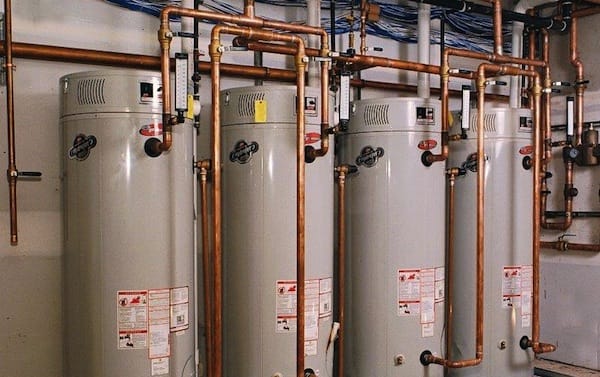Not long ago, contractors, engineers and building owners were routinely challenged by an inability to easily place and locate commercial water heaters. The limitations of atmospherically-vented systems, facility design, aesthetics and close proximity to other buildings all factored-in.

Bill Laurie, Jr. journeyman plumber with Edison, NJ-based Family Plumbing & Heating, Inc., checks main connection points for a new, multiple Bradford White eF water installation at a nearby Fairfield Inn.
Today it’s not uncommon for managers, late in the game, to express an aversion to visible venting, based purely on aesthetic reasons. This is especially true in historic districts.
Fortunately, many of the obstacles to easy placement of water heaters – at least those tied to building design and construction – are overcome with the emergence of new water heater systems, making it much easier to achieve manufacturer-specified combustion air or venting runs.
The arsenal of commercial water heater products and associated technology has grown considerably, availing a wide range of fuel, venting and combustion air options. There are also many new application-friendly components and techniques to enable trouble-free specification and installation, though – with the new, green systems — a few new needs emerge.
Higher efficiency, condensing systems like Bradford White’s eF system are great for end-users in terms of energy consumed, chiefly because they harvest heat from waste condensate. The energy advantage requires modest design and installation changes to meet the need for condensate treatment and drainage. This may translate to an inability to use existing venting if the original water heater was atmospherically vented, and the availability of electricity. Some systems require hard-wiring; other commercial systems need only a simple wall plug-in.

This finished installation of multiple Bradford White eF water heaters now provides a hotel with abundant sufficient hot water for the application. The redundancy of multiple water heaters assures that hotel guests will always have hot water.
Condensate drainage is a likely necessity. Often, fluids to be drained are too acidic for metal drain lines. Routing the condensate through a simple, lime-bed acid neutralizer may solve the problem easily. Better yet: CPVC or PVC drain lines can handle the acidity. Condensate typically has a pH of 4.0, about that of Coca-Cola – just enough to attack any metal it connects with. Over time, the cumulative effect of exposure to acidic runoff threatens the integrity of the drain lines.
Venting. If new, high-efficiency water heaters are planned as a retrofit, existing, single-wall B-vent must be replaced in favor of PVC, CPVC or ABS plastic. The majority of venting lines are three or four inches in diameter, precisely matched to the design requirements of new blower motor assemblies that discharge from the top of water heaters.
Plastic vent materials are inexpensive and easy to work with, and yet present no compromise in safety or performance. Some new water heater systems have the ability to vent through the roof and pull air in for combustion through the wall; this is a big advantage. The need to improve flexibility of installation and placement has driven the development of power, power direct vent; through-roof and side-wall venting options.

Brad Smith, COO of Springdale, AR-based Kimbel Mechanical Systems, Inc., performs a general start-up of a light commercial eF water heater.
Finally, if the application offers abundant atmospheric combustion air, some water heater models require only one pipe: for venting.
Multi-story and high-rise installations challenge traditional venting. High efficiency water heaters often can accommodate to long venting runs. Often, there’s no need to run vertical venting all the way to the roof, requiring a roof penetration. Many systems are now just as well served with side-wall venting.
New codes & standards are forcing all of us to be attentive to a broad range of emerging requirements. National, state and local codes are changing in the wake of the green movement’s more stringent environmental policies and initiatives. For more information on new energy efficiency standard for water heaters, https://mechanical-hub.com//more-regulation-the-final-rule-2015-water-heater-efficiency-standards.
Historic settings are commonly guarded by restrictions that regulate the presence and appearance of modern building systems and attachments (i.e., wire, regulators, transformers and venting). In fact, the presence of old and unsightly or loud venting systems has actually encouraged the replacement of aging atmospheric water heaters.




Join the conversation: